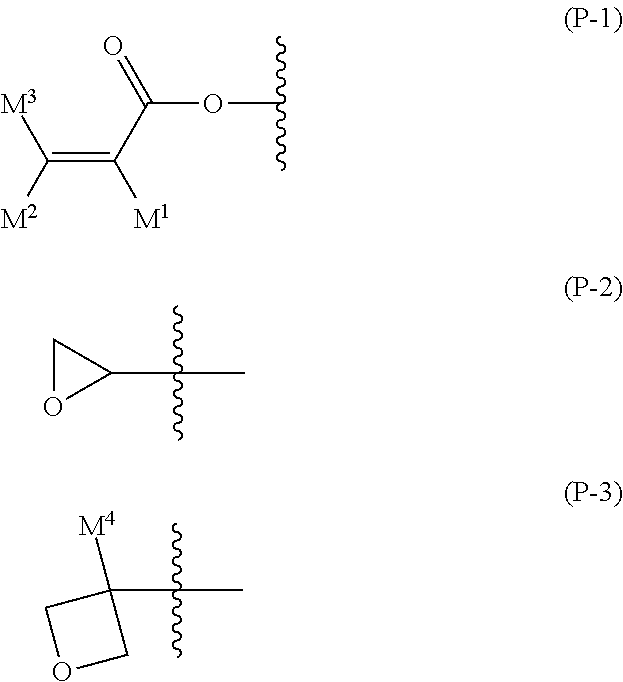Liquid crystal composition and liquid crystal display device
- Summary
- Abstract
- Description
- Claims
- Application Information
AI Technical Summary
Benefits of technology
Problems solved by technology
Method used
Image
Examples
examples
[0106]The invention will be explained in more details by way of examples, but is not limited to the examples. The invention includes a mixture of composition (LC-A) and composition (LC-B). The invention also includes a mixture prepared by mixing at least two compositions in Examples. Compounds prepared herein were identified by methods such as NMR analysis. The characteristics of the compounds, compositions and devices were measured by the methods described below.
[0107]NMR Analysis
[0108]A model DRX-500 apparatus made by Bruker BioSpin Corporation was used for the measurement. In the measurement of 1H-NMR, a sample was dissolved in a deuterated solvent such as CDCl3, and the measurement was carried out under the conditions of room temperature, 500 MHz and an accumulation of 16 scans. Tetramethylsilane was used as an internal standard. In the measurement of 19F-NMR, CFCl3 was used as the internal standard, and 24 scans were accumulated. In the explanation of the NMR spectra, the symbo...
examples 1
[0138]Composition (LC-A) was prepared by mixing the liquid crystal compounds described below. The components and characteristics of the composition were as follows.
[0139]Composition (LC-A)
3-H1OB(2F,3F)-O2(2-3)4%V2-BB(2F,3F)-O1(2-4)5%V2-BB(2F,3F)-O2(2-4)9%1V2-BB(2F,3F)-O2(2-4)6%V-HHB(2F,3F)-O1(2-6)3%V-HHB(2F,3F)-O2(2-6)10%3-HH1OB(2F,3F)-O2(2-8)11%2-BB(2F,3F)B-3(2-9)9%3-HH-V(3-1)27%3-HH-V1(3-1)9%3-HHB-O1(3-5)3%V-HHB-1(3-5)4%
[0140]NI=75.6° C.; Δn=0.111; Δε=−3.1.
[0141]Polymerizable compound (1-1-1-1) was added to the composition (LC-A) described above, and the mixture was heated at 120° C. for 5 min. The composition was placed in glass vials, which were kept at 25° C., 0° C., −10° C. and −20° C., respectively. After 7 days, whether the nematic phase had been maintained or crystals was deposited was determined by visual observation.
example 11
[0145]Polymerizable compound (1-1-1-1) was added to composition (LC-A) in a proportion of 0.80 wt %. The composition had NI of 75.5° C., Δn of 0.111, Δε of −3.1, and the values were almost equivalent to those of composition (LC-A). The composition was irradiated with UV light according to item 14) described above. Polymerization of compound (1-1-1-1) was not completed and was interrupted by setting up the conditions of light dose at 80 mW / cm2 for 375 sec. This method is suitable to evaluate the reactivity of a polymerizable compound and to measure an ability of the polymer giving a pretilt angle to liquid crystal molecules. After UV-irradiation, the concentration of the residual monomer was measured and found to be 0.61 wt %. The amount of compound (1-1-1-1) was reduced from 0.80 wt % to 0.61 wt % in spite of a small light dose. From the results, it was found that the compound had a good polymerizability. The pretilt angles were measured before and after the UV-irradiation according...
PUM
| Property | Measurement | Unit |
|---|---|---|
| Weight | aaaaa | aaaaa |
| Composition | aaaaa | aaaaa |
| Solubility (mass) | aaaaa | aaaaa |
Abstract
Description
Claims
Application Information
 Login to View More
Login to View More - R&D
- Intellectual Property
- Life Sciences
- Materials
- Tech Scout
- Unparalleled Data Quality
- Higher Quality Content
- 60% Fewer Hallucinations
Browse by: Latest US Patents, China's latest patents, Technical Efficacy Thesaurus, Application Domain, Technology Topic, Popular Technical Reports.
© 2025 PatSnap. All rights reserved.Legal|Privacy policy|Modern Slavery Act Transparency Statement|Sitemap|About US| Contact US: help@patsnap.com



